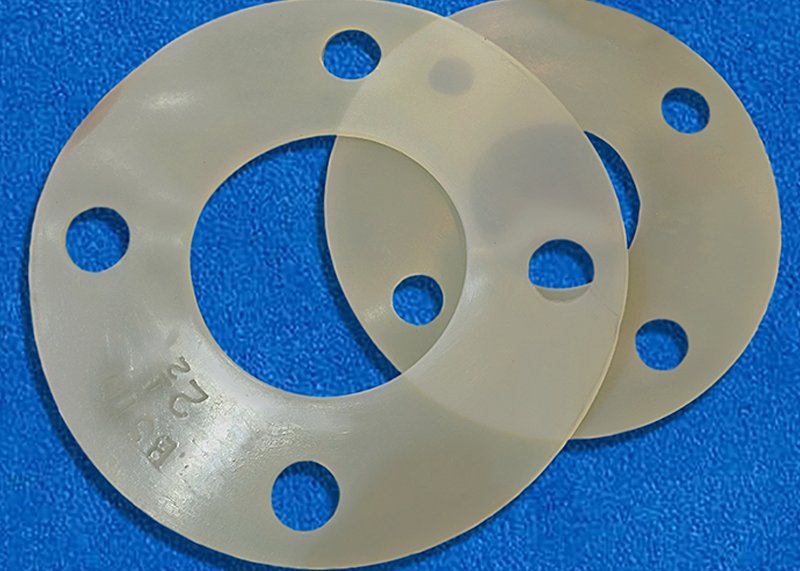At Mercer Gasket & Shim, we offer an exceptional range of materials to choose from. This enables our customers to order gaskets that meet the specific challenges of their operations. Most rubber, whether
natural or synthetic, is also available in sponge form (cellular rubber) in both open and closed cell grades.
Our highly knowledgeable team of engineers can guide you through the process of selecting the ideal rubber/PVC material for your unique gasket applications:
-
Butyl – A copolymer of isoprene of isobutylene, butyl is a synthetic rubber with several distinctive benefits. Butyl is impermeable to moisture and various gases, making it an ideal choice for
airtight applications. With a service temperature range of -40°F to 225°F, this material has exceptional resistance to chemicals, abrasion, and diverse weather conditions. Butyl can easily adhere
to other rubber materials, and it has great electrical insulation properties.
-
Ethylene Propylene Diene Monomer (EPDM) – Ethylene propylene diene monomer, commonly known as EPDM, is an elastomer known for its high durability and versatility. EPDM has excellent resistance to
heat, ozone, oxygen and oxygenated solvents, chemicals, animal and vegetable oils, and harsh weather. Stable in low and high temperatures, this material has a service range of - 40°F to 250°F and
is intermittent to 275°F. Additionally, EPDM can resist polar and steam substances with great proficiency.
-
Natural Rubber – Natural rubber is a polymer consisting of isoprene. This soft material has high elasticity, which provides superior physical properties such as resistance to abrasion and low
temperatures. Ideal for applications requiring acids, organic salts, and other chemicals, natural rubber is non-toxic and has a temperature range of -20°F to 170°F.
-
Neoprene – Neoprene is a synthetic rubber created by polymerizing chloroprene material. Also called polychloroprene, neoprene is a flame-retardant material that can also resist the effects of
oils, chemicals, oxygen, and ozone. For applications requiring higher tensile strength and ease of movement, cloth inserted neoprene is available; each variation can operate within the same - 20°F
to 170°F temperature range.
-
Nitrile (NBR, Buna-N) – Nitrile is a copolymer of butadiene and acrylonitrile. This synthetic rubber material is resistant to various solvents, hydraulic fluids, animal and vegetable oils, and
aromatic fuels; nitrile can also diminish the effects of heat aging. Nitrile performs optimally in temperatures ranging from -25°F to 170°F, and it is available in premium, commercial, and FDA
grades.
-
Styrene-butadiene rubber (SBR) – Styrene-butadiene rubber (SBR) has similar properties to natural rubber, but is more resistant to abrasion, wear, and hot and cold water. SBR has excellent
adhesion to metals, and is available in red rubber and cloth inserted varieties; the latter is more proficient at handling movement, high compression loads, and saturated and low pressure steam.
Each SBR variation can operate within the same -20°F to 170°F temperature range.
-
Silicone – An extremely soft and adaptable material, silicone is composed of polymerized siloxanes. Silicone boasts superior elastomeric properties at both high and low temperatures and is
resistant to the effects of ozone, oxygen, aging, ultraviolet (UV) light, and extreme weather conditions. Available in FDA grade, this material was a wide temperature service range of -67°F to
400°F and is intermittent to 450°F.
-
Viton® – Known for its outstanding resistance to chemical substances, Viton® is a fluorocarbonbased synthetic rubber. This material can perform optimally in the most extreme conditions— Viton® has
a maximum operating temperature from 400°F (continuous) to 500°F (intermittent). Additionally, this material can repel oxygen, ozone, various fuels and oils, solvents, and hydraulic fluids.
Most rubber, whether natural and synthetic, is also available in sponge form (cellular rubber) in both open and closed cell grades. Mercer offers neoprene, nitrile, silicone and Viton in sponge
form. Closed cell sponge is available for applications requiring high compressibility, while open cell is available for cushioning applications where sealing is not an issue.




